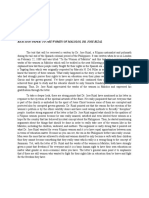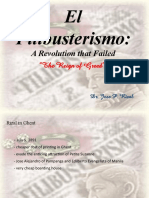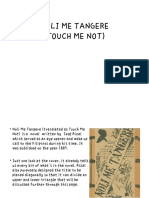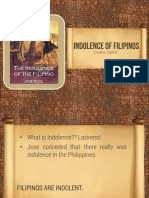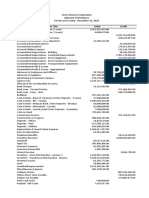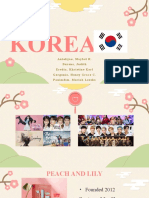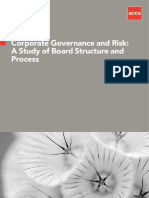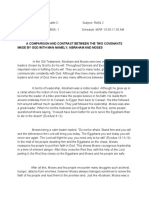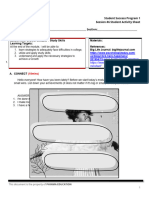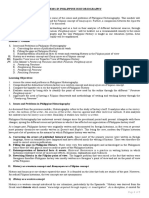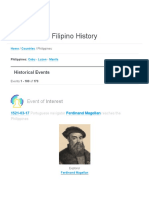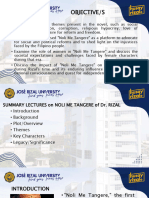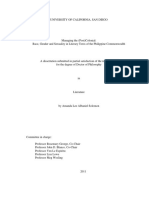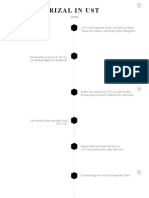Rizal Assignment 10
Rizal Assignment 10
Uploaded by
Judith DurensCopyright:
Available Formats
Rizal Assignment 10
Rizal Assignment 10
Uploaded by
Judith DurensOriginal Title
Copyright
Available Formats
Share this document
Did you find this document useful?
Is this content inappropriate?
Copyright:
Available Formats
Rizal Assignment 10
Rizal Assignment 10
Uploaded by
Judith DurensCopyright:
Available Formats
DURENS,JUDITH C.
Noli Me Tangere" is translated "Touch Me Not" or "The Social Cancer," while "El
Filibusterismo" is translated "The Reign of Greed." Both novels were about politically
and historically driven fictional Philippines during the Spanish colonial period inspired by
the writer's current living conditions, views, beliefs, and ideologies.
Compare and Contrast the Noli Me Tangere from El Filibusterismo
El Filibusterismo. The message of the novel is clear: the present system of
governing the Philippines through corrupt and self-seeking officials, dominated by
the friars and being submissive to their interests in one fashion or another, can only
lead to disaster for Spain.
Noli Metangere is actually a romantic story between Crisostomo Ibarra and Maria
Clara. Between the love story of Ibarra and Maria Clara is the historical narrative of
the time of Dr. Jose Rizal. Ibarra's journey in the world of Noli is the life of our
national hero: philosophy, controversy and mystery from Ibarra. Many people may
conclude that Rizal is Ibarra. Another character that may be reflected by Rizal is
the farmer who became Ibarra's mysterious friend. The theme of the novel is to
promote nationalism and to accept change in ourselves is still applies to us today.
We must patronize our country by respecting the law, promoting Philippine culture,
and realizing the true goal of the country by helping each other towards the
improvement of the country.
How is El Fili different from Noli Me?
1. The El Filibusterismo is a more disciplined novel, shorter and less meandering
than the Noli Me Tangere. Its tone is more consistent as well, although the earlier
parody and gothicism do recur occasionally. Noli is a love story or romance novel
dedicated to our homeland, and El fili is a political novel about revenge and
anger dedicated to GOMBURZA. The former is more of action and action, the
latter is thoughtful, discourse and dialect.
What differences/similarities did you find?
Similarities
1. In terms of similarities, Noli Me Tangere and El Filibusterismo have similarities in
terms of aim and purpose. Both aim to enlighten the Filipinos on what is
happening in the country. They want the people to fight for their country and have
the total freedom. One of the great books written by our national hero, Dr. Jose
Rizal.
2. Another way, Noli and El Fili are all talking about how Spaniards abused
Filipinos, abused church power, and discriminated against Filipinos. Both Noli
and El Fili showed strong anti-clerical and even anti-Catholic colors. They convey
a story because the latter is published in a sequel or sequel.
Differences
1. They are different in many cases. The first is Noli Metangere. The Latin title
means "Don't touch me", referring to the letters of John 20:17. When Mary
Magdalene tried to touch the newly resurrected Jesus, he said, "Don't touch me;
Don't touch me". Because I have not yet been promoted to my father. At the
same time, El filibusterismo is a Spanish title and is called the rule of greed in
English. Noli is a love story or romantic novel, dedicated to our motherland, and
El fili is politics.
2. The first is more on action and motion, the latter is thoughtful, discursive and
dialectal. Noli showed a sofspoken, patient, compassionate and idealistic
Crisostomo Ibarra while El Fili featured a different Ibarra who portrayed the angry
and vengeful side of him and disguised himself as the wealthy jeweller named
Simoun. Noli is written in the idea that would expose the ills of Philippine society
after Harriet Beecher Stowe's Uncle Tom's Cabin. In general Noli is more on the
reformist side of Rizal while El fili is on his revolutionist.
What is your opinion of the main character in El Filibusterismo?
1. Crisostomo Ibarra, who was the main character in Noli Me Tangere, comes back
as Simoun. He was described as a rich bearded jeweler who likes to wear blue
tinted glasses. Simoun is the protagonist of the sequel novel, known as the
henchmen of the captain, who became a cynical saboteur, planning a revolution
to avenge the Spanish regime. Simon's strategy is to influence the captain's
decision, make him make the wrong decision, and trigger a revolution. He is
known to be the influential in the Spanish colonial government in the Philippines
and has links to the Captain-General. He seeks to ignite the sentiments of the
Filipinos, so that a revolution may arise.
What do you think is Jose Rizal's message in the novel?
1. The story of Noli Me Tangere and El Filibusterismo gives off a
societal message that the citizens should be the leaders of its governing body
and not the other way around. That strength lies in the numbers of people who
want to change something inappropriate or give voices to those who suffer
injustices.
2. Driven by his undying love for his country, Rizal wrote the novel "Noli Me
Tangere and El Filibusterismo to expose the ills of Philippine society during the
Spanish colonial era. At the time, the Spaniards prohibited the Filipinos from
reading the controversial book because of the unlawful acts depicted in the
novel.
You might also like
- Rizal Answer KeyDocument17 pagesRizal Answer KeyMarkChristianRobleAlmazan87% (23)
- Group Thought Paper #2 (CANDELARIA, FALCIS, ELAGO, MANDARIO, VENTURA)Document3 pagesGroup Thought Paper #2 (CANDELARIA, FALCIS, ELAGO, MANDARIO, VENTURA)James Brian VenturaNo ratings yet
- Module 1: Republic Act 1425 "Rizal Law": ObjectivesDocument6 pagesModule 1: Republic Act 1425 "Rizal Law": ObjectivesJanelle PedreroNo ratings yet
- Del Rosario, Angel Paul B. September 18,2011 Eng1 - B-2R Reaction PaperDocument2 pagesDel Rosario, Angel Paul B. September 18,2011 Eng1 - B-2R Reaction PaperKatrina Santos100% (3)
- Ultimo AdiosDocument3 pagesUltimo AdiosFranchesca ValerioNo ratings yet
- Comparison of Noli and El FiliDocument32 pagesComparison of Noli and El FiliKevin Rey Caballeda62% (52)
- Chapter 3 Remembering RizalDocument2 pagesChapter 3 Remembering RizalArmilah Sultan MasarangaNo ratings yet
- Reaction Paper Bayaning 3rd WorldDocument2 pagesReaction Paper Bayaning 3rd Worldgatela jonathan jr.No ratings yet
- Reaction Paper To The Women of MalolosDocument2 pagesReaction Paper To The Women of MalolosStephen Rhey BoocNo ratings yet
- INTRODUCTIONxBODY ReflectionPaperRizalDocument3 pagesINTRODUCTIONxBODY ReflectionPaperRizalbry langNo ratings yet
- PReliminarydiscussion of NoliDocument41 pagesPReliminarydiscussion of NoliManuel J. RadislaoNo ratings yet
- Rizal ReflectionDocument2 pagesRizal ReflectionKristian TolentinoNo ratings yet
- Indolence of The FilipinoDocument15 pagesIndolence of The FilipinoIrish Ann IlustrisimoNo ratings yet
- Literary Works of Rizal - El FilibusterismoDocument4 pagesLiterary Works of Rizal - El FilibusterismoRica Mel MaalaNo ratings yet
- Why Is Rizal Considered The National Hero in The PhilippinesDocument4 pagesWhy Is Rizal Considered The National Hero in The PhilippinesVenice izza VenancioNo ratings yet
- Jose Rizal Philosophies in LifeDocument4 pagesJose Rizal Philosophies in LifeFrancisco Felipe BacangNo ratings yet
- Noli Me Tangere Diagnosi of Filipino SocietyDocument9 pagesNoli Me Tangere Diagnosi of Filipino Societyjoe jackNo ratings yet
- Mindanao State University: Gec 109-Life and Works of Jose RizalDocument5 pagesMindanao State University: Gec 109-Life and Works of Jose RizalNorsiya MontilaNo ratings yet
- What Is The Importance of Studying RizalDocument13 pagesWhat Is The Importance of Studying RizalJobeah D CaballeroNo ratings yet
- Rizal Report Rea and GacetaDocument20 pagesRizal Report Rea and Gacetacherry simonNo ratings yet
- REPORT in Readings in Philippine HistoryDocument28 pagesREPORT in Readings in Philippine HistoryDivine De GraciaNo ratings yet
- RC - Sucesos Islas de Filipinas Report - ReynosoDocument25 pagesRC - Sucesos Islas de Filipinas Report - ReynosoPatricia Tena50% (4)
- Topic: The Life of RizalDocument6 pagesTopic: The Life of RizalAndrew Miguel SantosNo ratings yet
- Chapter 2. WHY IS JOSE RIZAL OUR NATIONAL HERODocument1 pageChapter 2. WHY IS JOSE RIZAL OUR NATIONAL HEROAira Joy AnyayahanNo ratings yet
- A La Juventud FilipinaDocument4 pagesA La Juventud FilipinaHazel Tanwango-ToledoNo ratings yet
- A Deconstruction RA 1425 Aka Rizal's Law - Feminist ApproachDocument7 pagesA Deconstruction RA 1425 Aka Rizal's Law - Feminist ApproachJosemar D. Romano IINo ratings yet
- Our Task - To Make Rizal Obsolete Part 2 of 2Document9 pagesOur Task - To Make Rizal Obsolete Part 2 of 2Bert M DronaNo ratings yet
- Life of RizalDocument6 pagesLife of Rizal'Ardee TafallaNo ratings yet
- The Philippines A Century HenceDocument2 pagesThe Philippines A Century HenceRuby VentajarNo ratings yet
- Group Thought PaperDocument2 pagesGroup Thought PaperfabyunaaaNo ratings yet
- Chapter 3 (Life and Works of Rizal)Document20 pagesChapter 3 (Life and Works of Rizal)Law MaeNo ratings yet
- The Idolence of The FilipinoDocument3 pagesThe Idolence of The FilipinoLuna SebastianNo ratings yet
- Module-7 RizalDocument14 pagesModule-7 RizalLester Amado100% (3)
- 02 Rizal and The Theory of NationalismDocument2 pages02 Rizal and The Theory of NationalismMariza DurangoNo ratings yet
- Critical Essay Maningas PDFDocument3 pagesCritical Essay Maningas PDFKimNo ratings yet
- GEC109 - Ll2Document3 pagesGEC109 - Ll2Zumainah Bato AliNo ratings yet
- Jose Rizal Biographical Sketch: (Pilgrimage - Involve A Journey or Search of Moral or Spiritual Significance.)Document5 pagesJose Rizal Biographical Sketch: (Pilgrimage - Involve A Journey or Search of Moral or Spiritual Significance.)Gj Millen AlilioNo ratings yet
- Rizal Search For OriginDocument15 pagesRizal Search For Originnoresa comaraNo ratings yet
- 11 Evils During The Spanish EraDocument70 pages11 Evils During The Spanish EraEarl FarNo ratings yet
- Three (3) Things That I Significantly Learned From The ReadingsDocument2 pagesThree (3) Things That I Significantly Learned From The ReadingsJo MNo ratings yet
- Title of The Reading Hard To Imagine An Abridged by Benedict Anderson Reading Breakdown 1. What Is The Reading All About?Document2 pagesTitle of The Reading Hard To Imagine An Abridged by Benedict Anderson Reading Breakdown 1. What Is The Reading All About?FrancisNo ratings yet
- Rizal's Annotations To Inspire Young Filipinos of TodayDocument2 pagesRizal's Annotations To Inspire Young Filipinos of TodayClarina BerganteNo ratings yet
- Analysis of Noli Me TangereDocument1 pageAnalysis of Noli Me TangereDelliander Mirafuentes Stored McbellaNo ratings yet
- The Rise of Filipino NationalismDocument4 pagesThe Rise of Filipino NationalismJoshua Poblete DirectoNo ratings yet
- Sucessos de Las Islas FilipinasDocument29 pagesSucessos de Las Islas FilipinasRynne VistoNo ratings yet
- El Filibusterismo:: A Revolution That FailedDocument15 pagesEl Filibusterismo:: A Revolution That Failedjeff162450% (2)
- Letter To The Young Women of MalolosDocument12 pagesLetter To The Young Women of Maloloskyae.lopezNo ratings yet
- Sucesos de Las Islas Filipinas: Learning OutcomeDocument3 pagesSucesos de Las Islas Filipinas: Learning Outcomeaelin feyreNo ratings yet
- La Liga FilipinaDocument3 pagesLa Liga FilipinaDustinDwigthDoctoleroNo ratings yet
- Noli Me Tangere (Touch Me Not)Document11 pagesNoli Me Tangere (Touch Me Not)Edilhen ReyesNo ratings yet
- Life of RizalDocument2 pagesLife of RizalArian Keith AquinoNo ratings yet
- Alindada, Reaction Paper (Rizal 1998)Document2 pagesAlindada, Reaction Paper (Rizal 1998)Jam AlindadaNo ratings yet
- Noli Me TangereDocument3 pagesNoli Me TangereCrystal Padilla100% (1)
- Make A Reaction Paper Regarding The Film "Ang Buhay NG Isang Bayani"Document1 pageMake A Reaction Paper Regarding The Film "Ang Buhay NG Isang Bayani"Jane Apse100% (1)
- Our Task: To Make Rizal Obsolete: Prof. Renato ConstantinoDocument5 pagesOur Task: To Make Rizal Obsolete: Prof. Renato ConstantinoJon Joseph LlanoNo ratings yet
- RizalDocument13 pagesRizalCamlas Tallase RoyNo ratings yet
- A Viewing Assesment On The Film, Heneral Luna'Document3 pagesA Viewing Assesment On The Film, Heneral Luna'Desirie Rose LopenaNo ratings yet
- Lester D. Amado Bs Electrical Engineering-2 Rizal'S Life: Exile, Trial and Death ReflectionDocument3 pagesLester D. Amado Bs Electrical Engineering-2 Rizal'S Life: Exile, Trial and Death ReflectionLester AmadoNo ratings yet
- Context in Which Rizal Wrote El FiliDocument7 pagesContext in Which Rizal Wrote El FiliHeartNo ratings yet
- Philippines A Century HenceDocument14 pagesPhilippines A Century HenceNamoc, LeninNo ratings yet
- Module-2 - Nation and NationalismDocument15 pagesModule-2 - Nation and NationalismTrisha Pauline PangilinanNo ratings yet
- Assesment Module5Document4 pagesAssesment Module5johnpaul mosuelaNo ratings yet
- Life and Works of Rizal MidtermDocument3 pagesLife and Works of Rizal MidtermJean Bhea ValenciaNo ratings yet
- Assignment No. 2Document1 pageAssignment No. 2Judith DurensNo ratings yet
- Rizal's Second Travel AbroadDocument19 pagesRizal's Second Travel AbroadJudith DurensNo ratings yet
- Assignment No. 3Document1 pageAssignment No. 3Judith DurensNo ratings yet
- Indolence of FilipinosDocument11 pagesIndolence of FilipinosJudith DurensNo ratings yet
- The Women of RizalDocument25 pagesThe Women of RizalJudith DurensNo ratings yet
- Seven Heaven Corporation Adjusted Trial Balance For The Year Ended - December 31, 2019Document3 pagesSeven Heaven Corporation Adjusted Trial Balance For The Year Ended - December 31, 2019Judith DurensNo ratings yet
- GROUP 6 KoreaDocument6 pagesGROUP 6 KoreaJudith DurensNo ratings yet
- Factors Affecting The Choice of Buying Korean Cosmetics: Management Science Letters January 2020Document11 pagesFactors Affecting The Choice of Buying Korean Cosmetics: Management Science Letters January 2020Judith DurensNo ratings yet
- A1 FS PreparationDocument1 pageA1 FS PreparationJudith DurensNo ratings yet
- RR 129 001Document36 pagesRR 129 001Judith DurensNo ratings yet
- ReEd 2Document3 pagesReEd 2Judith DurensNo ratings yet
- Durens CVPDIYDocument1 pageDurens CVPDIYJudith DurensNo ratings yet
- Research and DevelopmentDocument2 pagesResearch and DevelopmentJudith DurensNo ratings yet
- Mae AnnDocument11 pagesMae AnnJudith DurensNo ratings yet
- SESSION#6 (sAS Growth Mindset - Study Skills SY 22-23 Yr1)Document10 pagesSESSION#6 (sAS Growth Mindset - Study Skills SY 22-23 Yr1)marryluvvieNo ratings yet
- Module 2 (Reviewer)Document5 pagesModule 2 (Reviewer)Mj PamintuanNo ratings yet
- Week 2 - Rizal The National HeroDocument67 pagesWeek 2 - Rizal The National HeroNanale Rolyn PortuNo ratings yet
- Philippine Literature (Spanish Period)Document57 pagesPhilippine Literature (Spanish Period)Zelskie CastleNo ratings yet
- Jose Rizal: Prepared By: Nil Christopher V. Anania LPTDocument36 pagesJose Rizal: Prepared By: Nil Christopher V. Anania LPTJaymar ReponteNo ratings yet
- Preliminary Activity A. PrayerDocument8 pagesPreliminary Activity A. PrayerRegine MalanaNo ratings yet
- Lesson 12 Womens of Jose Rizal QF PQM 051 03.05.2022 Rev.01 PPT Template WIDE SizeDocument17 pagesLesson 12 Womens of Jose Rizal QF PQM 051 03.05.2022 Rev.01 PPT Template WIDE SizekksasdjcNo ratings yet
- Filipino History - On This DayDocument42 pagesFilipino History - On This DayBingkat MacarimbangNo ratings yet
- Rizal and The RevolutionDocument8 pagesRizal and The RevolutionRenz AlconeraNo ratings yet
- DAYNOLO ExamDocument1 pageDAYNOLO ExamMaica Lourdes DaynoloNo ratings yet
- Explain The Rationale of Rizal LawDocument1 pageExplain The Rationale of Rizal LawMarie RamirezNo ratings yet
- Week 13 Rizal As A Novelist NoliDocument9 pagesWeek 13 Rizal As A Novelist Noliluiza-anne.lopezNo ratings yet
- Master-T Managing The (Post) ColonialDocument280 pagesMaster-T Managing The (Post) ColonialPiotr PardykaNo ratings yet
- Rizal in Ust: UST Is The Pontifical Royal, University of Santo Tomas, The Catholic University of The PhilippinesDocument14 pagesRizal in Ust: UST Is The Pontifical Royal, University of Santo Tomas, The Catholic University of The PhilippinesElijah PunzalanNo ratings yet
- The Life and Works of Rizal MODULE FINALSDocument59 pagesThe Life and Works of Rizal MODULE FINALSRexie MagastinoNo ratings yet
- El FilibusterismoDocument25 pagesEl FilibusterismoCarlo Dimaranan100% (1)
- ReportDocument5 pagesReportAngelo Joseph AgustinNo ratings yet
- Brown Scrapbook Museum of History Infographic PDFDocument1 pageBrown Scrapbook Museum of History Infographic PDFWeldon LabangNo ratings yet
- Final Book-ReviewDocument34 pagesFinal Book-ReviewJoshua Vergara CortelNo ratings yet
- Lesson 1 - Rizal Law and The Advent of A National HeroDocument2 pagesLesson 1 - Rizal Law and The Advent of A National HeroJeanne MarieNo ratings yet
- RIZALDocument2 pagesRIZALmary grace cornelioNo ratings yet
- The Philippines A Century HenceDocument2 pagesThe Philippines A Century Hencearleena rossNo ratings yet
- Rizal FinalDocument12 pagesRizal FinalJovelyn FriasNo ratings yet
- Module 8 - RizalDocument8 pagesModule 8 - RizalEmery PobleteNo ratings yet
- Rizal and The Propaganda MovementDocument2 pagesRizal and The Propaganda MovementEarl Luis Guiller SuarezNo ratings yet
- RA 1425 and Other Rizal LawsDocument17 pagesRA 1425 and Other Rizal LawsJohn Michael AgustinNo ratings yet
- The Spanish PeriodDocument3 pagesThe Spanish PeriodbequiliahoneygraceNo ratings yet








